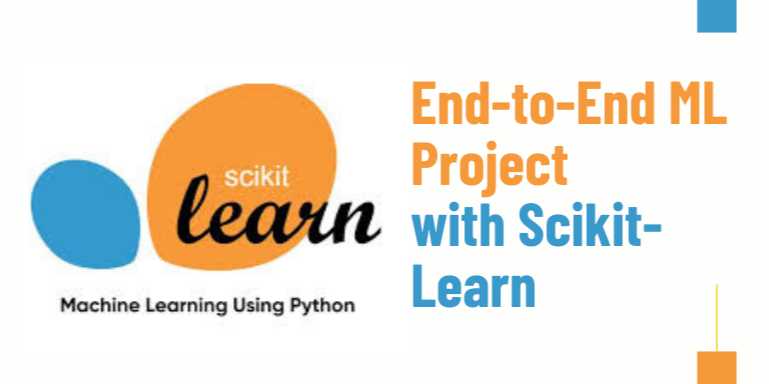Chapters
A Complete End-to-End Machine Learning Project with Scikit-Learn

Overview
📌 Why End-to-End Machine
Learning Projects Matter
In the world of data science and artificial intelligence, knowing
how to build a model isn’t enough. The real value comes from understanding
the entire lifecycle of a machine learning (ML) project — from
collecting and cleaning data to training, evaluating, and deploying a model
into a real-world system.
Too many learners focus solely on model tuning and accuracy
metrics, while overlooking the importance of proper data preprocessing,
pipeline design, reproducibility, and post-deployment monitoring. That’s why building
a full end-to-end project with tools like Scikit-Learn is not only
beneficial — it’s essential.
Scikit-Learn, one of the most widely used libraries in the
Python ecosystem, offers a clean and consistent interface for performing every
major step in the ML workflow. Whether you're a beginner or an intermediate
practitioner, mastering an end-to-end pipeline using Scikit-Learn will level up
your skills and set a strong foundation for working with more advanced
frameworks.
🧭 What This Project
Covers
In this tutorial, we’ll walk through a realistic end-to-end
machine learning project using Scikit-Learn. We’ll use a real dataset
(such as the California housing dataset or a Kaggle dataset) and cover all
phases of the ML workflow:
- Problem
Definition – Understanding the business and data context
- Data
Acquisition – Fetching or importing the dataset
- Exploratory
Data Analysis (EDA) – Gaining insights from the data
- Data
Preprocessing – Handling missing values, encoding, scaling
- Feature
Engineering – Creating meaningful inputs for the model
- Model
Selection – Comparing models and training
- Evaluation
– Metrics, cross-validation, and validation curves
- Hyperparameter
Tuning – Using GridSearchCV and RandomizedSearchCV
- Model
Deployment – Saving and reusing models with joblib or pickle
Each step will be accompanied by Scikit-Learn examples and
practical best practices.
🧮 Step 1: Problem
Definition
Before diving into code, it’s important to ask:
- What
are we trying to predict?
- What’s
the goal? (classification, regression, clustering?)
- Who
are the stakeholders?
Let’s assume we’re working on a regression problem:
predicting house prices based on features like location, square footage, number
of bedrooms, etc.
📥 Step 2: Data
Acquisition
Data can be acquired via:
- Built-in
Scikit-learn datasets (sklearn.datasets)
- CSV/Excel/JSON
files
- APIs
or web scraping
Example:
python
from
sklearn.datasets import fetch_california_housing
data
= fetch_california_housing(as_frame=True)
df
= data.frame
Or:
python
import
pandas as pd
df
= pd.read_csv('housing.csv')
🔍 Step 3: Exploratory
Data Analysis (EDA)
EDA is where we:
- Understand
the structure of the data
- Identify
missing values, outliers, and distributions
- Visualize
relationships
Tools:
- pandas,
matplotlib, seaborn
Key things to check:
- Correlation
matrix
- Histograms
- Pair
plots
- Value
counts (for categorical variables)
Example:
python
import
seaborn as sns
sns.heatmap(df.corr(),
annot=True)
🔧 Step 4: Data
Preprocessing
Scikit-Learn offers a variety of tools for data cleaning and
preparation:
- Handling
missing values (SimpleImputer)
- Scaling
features (StandardScaler, MinMaxScaler)
- Encoding
categorical variables (OneHotEncoder, OrdinalEncoder)
- Pipelines
(Pipeline, ColumnTransformer)
Example:
python
from
sklearn.pipeline import Pipeline
from
sklearn.preprocessing import StandardScaler
from
sklearn.impute import SimpleImputer
num_pipeline
= Pipeline([
('imputer',
SimpleImputer(strategy='median')),
('scaler', StandardScaler())
])
🛠️ Step 5: Feature
Engineering
Feature engineering helps improve model performance by:
- Creating
interaction terms
- Binning
continuous features
- Extracting
datetime features
- Creating
polynomial features
Scikit-learn provides:
- PolynomialFeatures
for feature expansion
- FunctionTransformer
for custom transformations
Example:
python
from
sklearn.preprocessing import PolynomialFeatures
poly
= PolynomialFeatures(degree=2)
X_poly
= poly.fit_transform(df[['feature1', 'feature2']])
🤖 Step 6: Model Training
and Selection
Scikit-learn has a vast collection of models:
|
Task |
Models |
|
Classification |
LogisticRegression,
RandomForestClassifier, SVC |
|
Regression |
LinearRegression,
RandomForestRegressor, SVR |
|
Clustering |
KMeans, DBSCAN |
Example:
python
from
sklearn.ensemble import RandomForestRegressor
model
= RandomForestRegressor()
model.fit(X_train,
y_train)
You can use the cross_val_score method for performance
estimation:
python
from
sklearn.model_selection import cross_val_score
scores
= cross_val_score(model, X_train, y_train, cv=5)
📏 Step 7: Model
Evaluation
Common metrics for regression:
- MAE
(Mean Absolute Error)
- MSE
(Mean Squared Error)
- RMSE
(Root Mean Squared Error)
- R²
Score
Example:
python
from
sklearn.metrics import mean_squared_error, r2_score
predictions
= model.predict(X_test)
mse
= mean_squared_error(y_test, predictions)
r2
= r2_score(y_test, predictions)
🔍 Step 8: Hyperparameter
Tuning
Use GridSearchCV or RandomizedSearchCV to find the best
parameters.
Example:
python
from
sklearn.model_selection import GridSearchCV
param_grid
= {
'n_estimators': [50, 100],
'max_depth': [10, 20],
}
grid_search
= GridSearchCV(RandomForestRegressor(), param_grid, cv=5)
grid_search.fit(X_train,
y_train)
🚀 Step 9: Saving and
Deploying the Model
Use joblib or pickle to persist the model for reuse or
deployment:
python
import
joblib
joblib.dump(model,
'house_price_model.pkl')
#
Later for loading
loaded_model
= joblib.load('house_price_model.pkl')
You can deploy your model using:
- Flask/FastAPI
for REST APIs
- Streamlit
or Gradio for UI
- Docker
for containerized apps
🧾 Summary Table: Key
Steps and Tools
|
Step |
Tool/Method |
|
Data Loading |
pandas,
sklearn.datasets |
|
EDA |
matplotlib,
seaborn, pandas profiling |
|
Preprocessing |
Pipeline, ColumnTransformer,
Scaler |
|
Feature Engineering |
PolynomialFeatures,
FunctionTransformer |
|
Model Training |
RandomForest,
LinearRegression, SVC |
|
Evaluation |
cross_val_score,
metrics module |
|
Hyperparameter
Tuning |
GridSearchCV,
RandomizedSearchCV |
|
Saving & Loading |
joblib,
pickle |
💡 Final Thoughts
An end-to-end machine learning project is more than a coding
exercise — it's a systematic problem-solving approach. Scikit-Learn’s
flexibility allows developers and analysts to build robust, modular, and
reproducible ML systems quickly. From data ingestion and preprocessing to model
tuning and saving, Scikit-Learn brings consistency and clarity to the ML
pipeline.
By practicing an entire pipeline with real-world data, you
gain critical thinking skills, expose hidden assumptions, and become better
prepared for practical machine learning work — whether in research, industry,
or freelancing.
FAQs
1. What is meant by an end-to-end machine learning project?
An end-to-end machine learning project includes all stages of development, from defining the problem and gathering data to training, evaluating, and deploying the model in a real-world environment.
2. Why should I use Scikit-Learn for an end-to-end ML project?
Scikit-Learn is widely adopted due to its simplicity, clean API, and comprehensive set of tools for data preprocessing, modeling, evaluation, and tuning, making it ideal for full ML workflows.
3. Can I use Scikit-Learn for deep learning projects?
Scikit-Learn is not designed for deep learning. For such use cases, you should use frameworks like TensorFlow or PyTorch. However, Scikit-Learn is perfect for classical ML tasks like classification, regression, and clustering.
4. How do I handle missing values using Scikit-Learn?
You can use SimpleImputer from sklearn.impute to fill in missing values with mean, median, or most frequent values as part of a pipeline.
5. What is the advantage of using a pipeline in Scikit-Learn?
Pipelines help you bundle preprocessing and modeling steps together, ensuring consistency during training and testing and reducing the chance of data leakage.
6. How can I evaluate my model’s performance properly?
You should split your data into training and test sets or use cross-validation to assess performance. Scikit-Learn offers metrics like accuracy, F1-score, RMSE, and R² depending on the task.
7. Is it possible to deploy Scikit-Learn models into production?
Yes, models trained with Scikit-Learn can be serialized using joblib or pickle and deployed using tools like Flask, FastAPI, or cloud services such as AWS and Google Cloud.
8. What is cross-validation and why is it useful?
Cross-validation is a method of splitting the data into multiple folds to ensure the model generalizes well. It helps detect overfitting and gives a more reliable performance estimate.
9. How do I tune hyperparameters with Scikit-Learn?
You can use GridSearchCV or RandomizedSearchCV to automate hyperparameter tuning and select the best model configuration based on performance metrics.
10. Can Scikit-Learn handle categorical variables?
Yes, using transformers like OneHotEncoder or OrdinalEncoder, and integrating them within a ColumnTransformer, Scikit-Learn can preprocess both categorical and numerical features efficiently.
Posted on 05 May 2025, this text provides information on machine learning. Please note that while accuracy is prioritized, the data presented might not be entirely correct or up-to-date. This information is offered for general knowledge and informational purposes only, and should not be considered as a substitute for professional advice.


Comments(1)